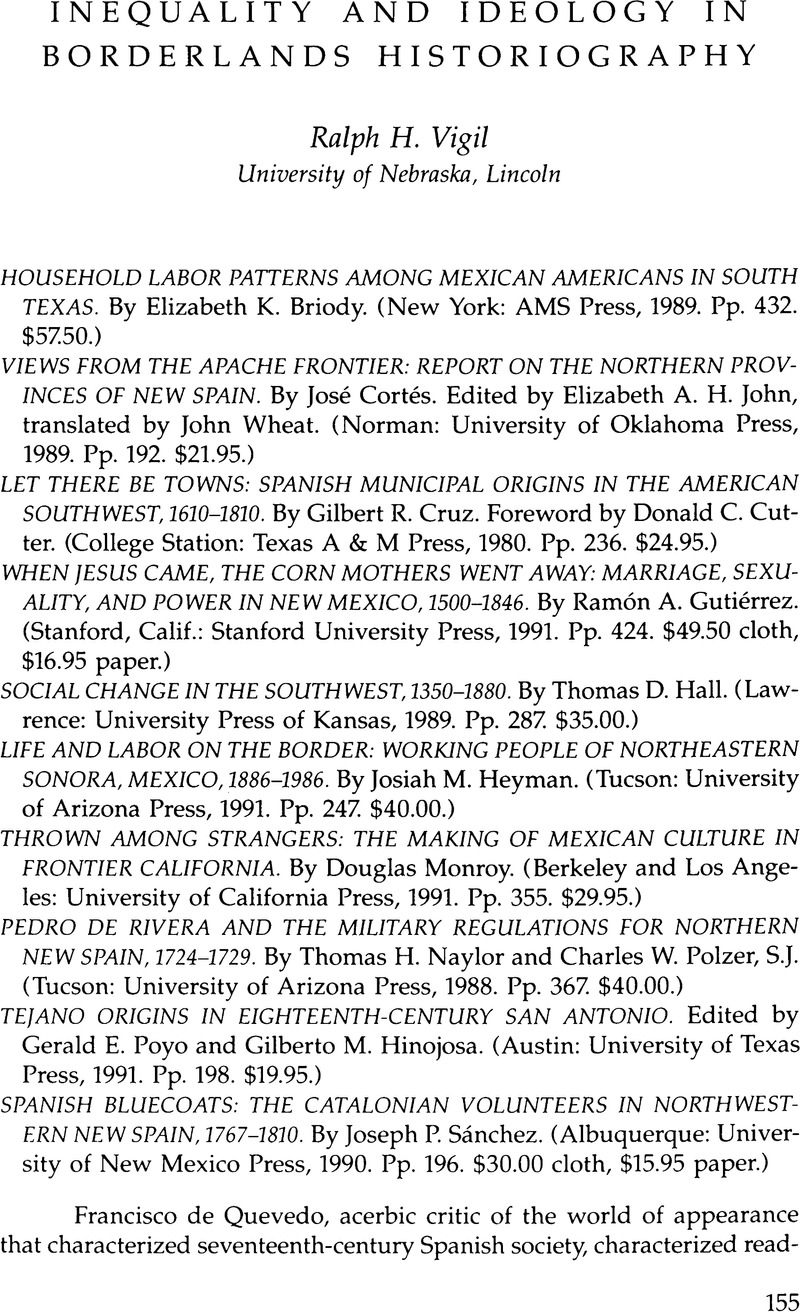Article contents
Inequality and Ideology in Borderlands Historiography
Review products
Published online by Cambridge University Press: 05 October 2022
Abstract

- Type
- Review Essays
- Information
- Copyright
- Copyright 1994 by the University of Texas Press
References
1. Karl Mannheim, Ideology and Utopia: An Introduction to the Sociology of Knowledge, translated by Louis Wirth and Edward Shils (New York: Harcourt, Brace, and World, n.d.; first published in 1936), 48, 276.
2. Ibid., p. xxiii. Perhaps the best example of the absence of common values in society is the schizoid subjectivism of much contemporary art. See Roland N. Stromberg, After Everything: Western Intellectual History since 1945 (New York: St. Martin's, 1975), 94.
3. Mannheim, Ideology and Utopia, 23.
4. Diane Ravitch, Multiculturalism, E Pluribus Plures, American Scholar 59 (Summer 1990):33754.
5. Carey McWilliams, North from Mexico: The Spanish-Speaking People of the United States, reprinted in 1968 by Greenwood Press and translated into Spanish in the same year. The edition I have used is a new one, updated by Matt S. Meier and published by Praeger in 1990.
6. Ralph H. Vigil, The New Borderlands History: A Critique, New Mexico Historical Review 48 (July 1973):189208.
7. McWilliams, North from Mexico, 29.
8. See The Black Legend: Anti-Spanish Attitudes in the Old World and the New, edited by Charles Gibson (New York: Knopf, 1971).
9. See Vigil, The New Borderlands History, p. 193; p. 204, n. 26.
10. See, for example, Robert F. Berkhofer, Jr., The White Man's Indian: Images of the American Indian from Columbus to the Present (New York: Vintage Books, 1978), 7275; and Donaciano Vigil, Arms, Indians, and the Mismanagement of New Mexico, edited and translated by David J. Weber (El Paso: Texas Western Press, 1986), 7.
11. Benjamin Keen, The Aztec Image in Western Thought (New Brunswick, N.J.: Rutgers University Press, 1971), 218.
12. See articles on the presidio and the soldado de cuera in The Spanish Borderlands: A First Reader, edited by Oakah L. Jones, Jr. (Los Angeles, Calif.: Lorrin L. Morrison, 1974). The essays were first published in the journal of the West.
13. Keen, The Aztec Image, 218.
14. Berkhofer, The White Man's Indian, 78.
15. Lesley Byrd Simpson, Many Mexicos (Berkeley and Los Angeles: University of California Press, 1959), 25.
16. John Francis Bannon, The Spanish Borderlands Frontier, 15131821 (New York: Holt, Rinehart, and Winston, 1970), 5.
17. Jacques Lafaye and James Lockhart, A Scholarly Debate: The Origins of Modern MexicoIndigenistas vs. Hispanistas, The Americas 48 (Jan. 1992):31530.
18. Stromberg, After Everything, 208.
19. Ralph H. Vigil, New Ethnic Literature: A Review Essay, New Mexico Historical Review 49 (Apr. 1974):15370.
20. See Cormac McCarthy's Blood Meridian or The Evening Redness in the West (New York: Vintage Books, 1992), 307. This epic Western based on historical events personifies in Holden the judge the violence and depravity of U.S. westward expansion. He mistakenly believes that war against Indians is the ultimate game, failing to see that the murder of Indians and the marketing of Indian scalps are neither a contest nor a game with rules that are absolutely binding and allow no doubt. As Johan Huizinga remarked, war's cultural function ended in the twentieth century with the theory of total war. See Huizinga, Homo Ludens: A Study of the Play Element in Culture (Boston, Mass.: Beacon, 1955), 11, 20910.
21. It is also obvious that whether one types oneself as an ethnic, a member of a minority, or part of mainstream society, in the United States, everyone is influenced by the work place, the automobile, schools, and the mass media, all of which have helped create mass values, attitudes, and habits. Herbert Marcuse asked, Can one really distinguish between the mass media as instruments of information and entertainment, and as agents of manipulation and indoctrination? See Marcuse, One-Dimensional Man (Boston, Mass.: Beacon, 1966), 8.
22. Robert Hughes, America's Culture of Complaint, Time, no. 139 (Feb. 1992):4449.
23. Berdaches were males who dressed as women and acted as passive homosexual partners. See also Spanish puto, English catamite, and French bardache.
24. Berkhofer, The White Man's Indian, 17879.
25. Ibid., 2728.
26. J. Manuel Espinosa, Crusaders of the Ro Grande: The Story of Don Diego de Vargas and the Reconquest and Refounding of New Mexico (Chicago, Ill.: Institute of Jesuit History, 1942), 312.
27. Oakah L. Jones, Jr., Los Paisanos, Spanish Settlers on the Northern Frontier of New Spain (Norman: University of Oklahoma Press, 1979), 148.
28. Magnus Mrner, Race Mixture in the History of Latin America (Boston, Mass.: Little, Brown, 1967), 66.
29. Ibid., 67.
30. Ibid., 97102.
31. See Fray Anglico Chavez, Jos Gonzales, Genzaro Governor, New Mexico Historical Review 30 (July 1955):190-94; Chvez, The Penitentes of New Mexico, New Mexico Historical Review 29 (Apr. 1954):97-123; and Frances Leon Swadesh, Los Primeros Pobladores: Hispanic American of the Ute Frontier (Notre Dame, Ind.: University of Notre Dame Press, 1974), 159, 23132, n. 1. See also Russell M. Magnaghi, Plains Indians in New Mexico: The Genzaro Experience, Great Plains Quarterly 10 (Spring 1990):8695.
32. W. W. H. Davis, El Gringo, or, New Mexico and Her People (New York: Harper and Brothers, 1857), 316.
33. Thomas E. Chavez, Manuel Alvarez, 17941856: A Southwestern Biography (Niwot, Colo.: University Press of Colorado, 1990), 189.
34. Jack Miles, Immigration and the New American Dilemma: Blacks vs. Browns, The Atlantic, no. 270 (Oct. 1992):4168.
35. Pablo Gonzlez Casanova, Democracy in Mexico, translated by Danielle Salti (London: Oxford University Press, 1972).
36. Rodolfo Acua, Occupied America: The Chicano's Struggle toward Liberation (San Francisco, Calif.: Canfield, 1972), iii, 277.
37. R. H. Tawney, Religion and the Rise of Capitalism (New York: Mentor, 1954), 27.
38. Robert Frost, The Lesson for Today, in The Poems of Robert Frost (New York: Modern Library, 1946), 4038.
39. Stromberg, After Everything, 127.
40. Ramn Eduardo Ruiz, The People of Sonora and Yankee Capitalists (Tucson: University of Arizona Press, 1988).
41. Ravitch, Multiculturalism, 340.
- 1
- Cited by




